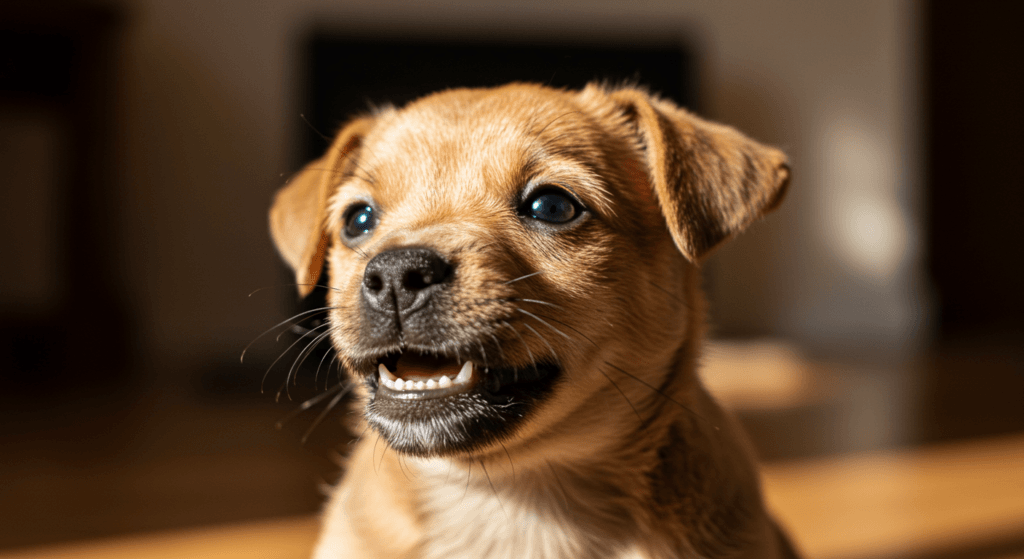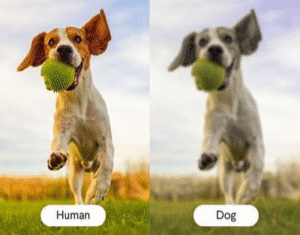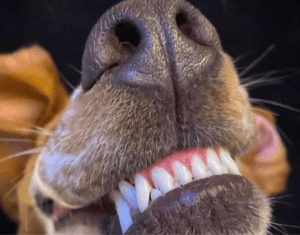Ever wondered what’s lurking inside your dog’s mouth (besides the sock they just stole, yesterday’s kibble crumbs, and that one thing you really hope isn’t a bug)? Well, you’re in for a treat because today, we’re diving deep into the fascinating, sometimes chaotic world of dog teeth!
We’re talking puppy teeth, adult teeth, what they’re used for, and how to keep those chompers in top shape because your pup’s smile is almost as important as their adorable zoomies. Whether they’re using their teeth to munch on treats, playfully nibble your fingers, or destroy your favorite slippers, knowing what’s going on inside their mouth is key to keeping them happy and healthy.
目录
So grab your pup, maybe a chew toy (because they’ll definitely get ideas), and buckle up, fellow pet parents; this is going to be one toothy, tail-wagging, laugh-out-loud adventure!
Puppy Teeth: The “Milk Teeth” Phase
Before your dog turns into a full-fledged sock-destroyer and professional chew enthusiast, they start with puppy teeth, also called deciduous teeth (because, like baby teeth in humans, they eventually fall out). Here’s what you need to know:
- Puppies have 28 tiny, needle-like teeth that are surprisingly powerful for their size.
- These teeth start coming in around 3-4 weeks of age, making your pup’s mouth an adorable but dangerous place.

- By the time your pup is 8 weeks old, they should have all their puppy teeth and just in time to start testing them on your fingers, furniture, and favorite shoes.
- And guess what? These teeth are razor-sharp. If you’ve ever been on the receiving end of a puppy nibble, you know the struggle and why good chew toys are a must!
Why Are Puppy Teeth So Sharp?
Have you ever noticed how those little teeth feel like tiny needles? That’s because puppies are natural chewers. Their razor-sharp teeth help them learn important life skills, like play-biting, which teaches bite inhibition and chewing on appropriate objects, hopefully not your expensive sneakers or the corner of your coffee table.
But don’t get too attached to those mini daggers. Puppy teeth start falling out around 12-16 weeks, making way for their adult teeth to make a grand and slightly less painful entrance.
Adult Dog Teeth: The Full Set
Once your pup has outgrown their baby teeth, its permanent teeth come in. And boy, do they come in strong! Designed for everything from tearing into kibble to gnawing on their favorite chew toy (or, let’s be honest, your furniture), these teeth mean business. Whether they’re gently carrying a tennis ball or determinedly shredding a stick into a million tiny pieces, every tooth plays a role in your dog’s daily adventures.
How Many Teeth Do Adult Dogs Have?
A full-grown dog boasts 42 adult teeth, which is 10 more than humans! And trust me, they put them to good use. Here’s how they’re distributed:
- Incisors (12 total):(six on top, six on the bottom).
- Canines (4 total): The fangs!
- Premolars (16 total)
- Molars (10 total)
When Do Adult Teeth Come In?
By six months old, your dog should have all their adult teeth locked and loaded, ready for a lifetime of chewing, chomping, and occasionally gnawing on things they shouldn’t. If you notice gaps, missing teeth, or stubborn baby teeth that just won’t budge, it might be time for a vet visit.
Sometimes, those tiny puppy teeth don’t get the memo that their lease is up, leading to overcrowding, misalignment, and even discomfort. Think of it like having a roommate who refuses to move out, eventually, someone (your vet) has to step in and make things right!
What Each Tooth Type Is Used For
Now that we’ve counted your dog’s teeth like a pro, let’s talk about what they actually do. Every tooth has a purpose, and trust me, they put them to work every single day if it’s for eating, playing, or committing minor household destruction.
- Incisors – The Handy Helpers: These tiny front teeth are used for picking up small objects, self-grooming, and (very inefficiently) trying to steal a bite of your sandwich when you’re not looking.
- Canines – The Mighty Chompers: Also known as the “vampire” teeth, these sharp fangs are built for gripping and tearing meat. Whether it’s actual food or the plush toy they’ve sworn to de-stuff within five minutes.
- Premolars – The Multitasking Chewers: Positioned right behind the canines, these guys are the real MVPs for shearing and chewing. Ever notice your dog crunch a treat sideways? That’s them putting their premolars to work like a pro.
- Molars – The Heavy Lifters: Tucked at the back, molars do the serious grinding and crushing. These teeth break down kibble, tough treats, and sometimes that suspiciously expensive shoe they got their paws on.
Common Dental Problems in Dogs
Your dog’s teeth go through a lot chewing, fetching, and sometimes gnawing on things they absolutely shouldn’t. So, it’s no surprise that dental issues can creep up. Here are some of the most common culprits:
- Plaque & Tartar Build-Up – The Sneaky Troublemakers
Just like in humans, plaque (a sticky film of bacteria) forms on a dog’s teeth and, if not removed, hardens into tartar. Too much tartar leads to gum disease and bad breath, and let’s be honest, dog breath is already a challenge on a good day. - Gingivitis & Periodontal Disease
If your dog’s gums are red and inflamed, that’s gingivitis, a not-so-subtle warning that their teeth need some serious TLC. Left unchecked, it can escalate into periodontal disease, leading to tooth loss, infections, and a whole lot of vet bills. - Broken or Cracked Teeth
Dogs love to chew, but sometimes their enthusiasm backfires. Gnawing on hard objects like bones, antlers, or even tough chew toys can lead to cracked or broken teeth. And yes, a broken tooth is just as painful for dogs as it is for us! In severe cases, it might even require a doggy root canal (yep, those exist) or extraction. - Retained Puppy Teeth – When Baby Teeth Won’t Let Go
Some dogs, especially smaller breeds, hold onto their baby teeth longer than they should. This can cause overcrowding, misalignment, and an increased risk of decay. If you notice double rows of teeth (like a little shark situation), it’s best to get them checked out by a vet before things get messy.
How to Keep Your Dog’s Teeth Healthy
Good dental hygiene isn’t just a human thing; your pup needs a solid toothcare routine, too! Healthy teeth = a happy, pain-free pup (and fresher breath, which is a bonus for everyone). Here’s how to keep those canines in top shape:
1. Brush Their Teeth (Yes, Really!)

- Use dog-specific toothpaste: human toothpaste contains xylitol, which is toxic to dogs! Check out Amzon for their toothpaste
- Start slow and make it a positive experience; lots of treats and praise will help.
- Aim for brushing 3-4 times a week (or daily if you’re feeling ambitious).
2. Dental Chews & Toys – The Fun Way to Clean Teeth
- Chewing naturally scrapes off plaque and keeps gums healthy.
- Look for vet-approved dental treats and toys designed to promote oral health. Jollyes offers the best
- Avoid overly hard chews (like bones or antlers) to prevent broken teeth.
3. Regular Vet Checkups
- Your vet can spot dental problems early and recommend professional cleanings if needed.
- Some breeds (like Yorkies, Pugs, and Chihuahuas) need extra dental care due to their smaller mouths and crowded teeth.
- If your dog has bad breath that won’t quit, it might be a sign of underlying dental issues, so don’t ignore it!
4. Diet & Hydration
- Crunchy kibble acts like a natural toothbrush, helping to scrape away plaque. Meanwhile, wet food (though tasty) can stick to teeth and cause more buildup.
- Some dental diets are specially formulated to reduce plaque and tartar, so ask your vet for recommendations.
- Plenty of fresh water is essential! It helps wash away food particles and keeps gums hydrated and healthy.
Final Thoughts: Why Dog Dental Care Matters
Taking care of your dog’s teeth isn’t just about fresh breath (though that’s a definite perk!). It’s about preventing pain, infections, and expensive vet bills down the line. Dental issues can sneak up fast, but with a little effort, like regular brushing, dental chews, and vet checkups, you can keep your pup’s smile healthy and strong. Whether your dog is still in the puppy teething phase or already rocking a full set of 42 adult chompers, a solid dental routine will keep those teeth in top shape for years to come.
主要收获
- Puppies start with 28 sharp baby teeth, which fall out around 12-16 weeks.
- Adult dogs have 42 teeth, including incisors, canines, premolars, and molars.
- Each tooth type has a unique function, from nibbling to grinding.
- Common dental problems include plaque, gingivitis, and broken teeth.
- Brushing, dental chews, and vet checkups keep your dog’s teeth healthy.
So, next time your dog flashes that adorable grin, you’ll know exactly what’s going on in that mouth of theirs! Now, go give your pup a treat (preferably one that helps their teeth) and celebrate their perfect doggy smile!





